A Statistical Method to Predict Flow Permanence in Dryland Streams from Time Series of Stream Temperature
Abstract
1. Introduction
2. Materials and Methods
2.1. Field Data Collection
2.2. Statistical Analyses
3. Results
4. Discussion
Acknowledgments
Author Contributions
Conflicts of Interest
References
- Jaeger, K.L.; Olden, J.D.; Pelland, N.A. Climate change poised to threaten hydrologic connectivity and endemic fishes in dryland streams. Proc. Natl. Acad. Sci. USA 2014, 38, 13894–13899. [Google Scholar] [CrossRef] [PubMed]
- Datry, T.; Arscott, D.B.; Sabater, S. Recent perspectives on temporary river ecology. Aquat. Sci. 2011, 73, 453–457. [Google Scholar] [CrossRef]
- Morisawa, M.E. Accuracy of determination of stream lengths from topographic maps. Eos Trans. AGU 1957, 38, 86–88. [Google Scholar] [CrossRef]
- Fritz, K.M.; Hagenbuch, E.; D’Amico, E.; Reif, M.; Wigington, P.J., Jr.; Leibowitz, S.G.; Comeleo, R.L.; Ebersole, J.L.; Nadeau, T. Comparing the Extent and Permanence of Headwater Streams from Two Field Surveys to Values from Hydrographic Databases and Maps. J. Am. Water Resour. Assoc. 2013, 49, 867–882. [Google Scholar] [CrossRef]
- Sando, R.; Blasch, K.W. Predicting alpine headwater stream intermittency: A case study in the northern Rocky Mountains. Ecohydrol. Hydrobiol. 2015, 15, 68–80. [Google Scholar] [CrossRef]
- Constantz, J.; Stonestrom, D.; Stewart, A.E.; Niswonger, R.; Smith, T.R. Analysis of streambed temperatures in ephemeral channels to determine streamflow frequency and duration. Water Resour. Res. 2001, 37, 317–328. [Google Scholar] [CrossRef]
- Bhamjee, R.; Lindsay, J.B. Ephemeral stream sensor design using state loggers. Hydrol. Earth Syst. Sci. 2011, 15, 1009–1021. [Google Scholar] [CrossRef]
- Isaak, D.J.; Wenger, S.J.; Peterson, E.E.; Ver Hoef, J.M.; Hostetler, S.W.; Luce, C.H.; Dunham, J.B.; Kershner, J.L.; Roper, B.B.; Nagel, D.E.; et al. NorWeST Modeled Summer Stream Temperature Scenarios for the Western U.S. Fort Collins, CO. For. Serv. Res. Data Arch. 2016. [Google Scholar] [CrossRef]
- Sowder, C.; Steel, E.A. A note on the collection and cleaning of water temperature data. Water 2012, 4, 597–606. [Google Scholar] [CrossRef]
- Blasch, K.W.; Ferré, T.; Hoffman, J.P. A statistical technique for interpreting streamflow timing using streambed sediment thermographs. Vadose Zone J. 2004, 3, 936–946. [Google Scholar] [CrossRef]
- Dunham, J.B.; Chandler, G.L.; Rieman, B.E.; Martin, D. Measuring Stream Temperature with Digital Data Loggers: A User’s Guide; Rocky Mountain Research Center General Technical Report RMRS-GTR-150WWW; U.S. Dep. Agric., Forest Service: Fort Collins, CO, USA, 2005. [CrossRef]
- Zucchini, W.; MacDonald, I. Hidden Markov Models for Time Series: An Introduction Using R, 1st ed.; CRC Press: Boca Raton, FL, USA, 2009; ISBN 978-1-58488-573-3. [Google Scholar]
- Blasch, K.W.; Ferré, T.; Christensen, A.H.; Hoffman, J.P. New field method to determine streamflow timing using electrical resistance sensors. Vadose Zone J. 2002, 1, 289–299. [Google Scholar] [CrossRef]
- Schultz, L.D.; Heck, M.P.; Hockman-Wert, D.; Allai, T.; Wenger, S.; Cook, N.A.; Dunham, J.B. Spatial and temporal variability in the effects of wildfire and drought on thermal habitat for a desert trout. J. Arid Environ. 2017, 145, 60–68. [Google Scholar] [CrossRef]
- Heck, M.P.; Schultz, L.D.; Hockman-Wert, D.; Dinger, E.; Dunham, J.B. Monitoring stream temperatures: A guide for non-specialists. 2017; manuscript in preparation. [Google Scholar]
- Chapin, T.P.; Todd, A.S.; Zeigler, M.P. Robust, low-cost data loggers for stream temperature, flow intermittency, and relative conductivity monitoring. Water Resour. Res. 2014, 50, 6542–6548. [Google Scholar] [CrossRef]
- Visser, I. Seven things to remember about hidden Markov models: A tutorial on Markovian models for time series. J. Math. Psychol. 2011, 55, 403–415. [Google Scholar] [CrossRef]
- Visser, I.; Speekenbrink, M. depmixS4: An R Package for Hidden Markov Models. J. Stat. Softw. 2010, 36, 1–21. [Google Scholar] [CrossRef]
- R Development Core Team. R: A Language and Environment for Statistical Computing; R Foundation for Statistical Computing: Vienna, Austria, 2011; ISBN 3-900051-07-0. [Google Scholar]
- Bhamjee, R.; Lindsay, J.B.; Cockburn, J. Monitoring ephemeral headwater streams: A paired sensor approach. Hydrol. Process. 2016, 30, 888–898. [Google Scholar] [CrossRef]
- Gungle, B. Timing and Duration of Flow in Ephemeral Streams of the Sierra Vista Subwatershed of the Upper San Pedro River Basin, Cochise County, Southeastern Arizona; Scientific Investigations Report 2005–5190, Govt. Doc. Number I 19.42/4-4:2005-5190; United States Geological Survey: Reston, VA, USA, 2006.
- Arismendi, I.; Johnson, S.L.; Dunham, J.B. Technical Note: Higher-order statistical moments and a procedure that detects potentially anomalous years as two alternative methods describing alterations in continuous environmental data. Hydrol. Earth Syst. Sci. 2015, 11, 1169–1180. [Google Scholar] [CrossRef]
- Acuña, V.; Datry, T.; Marshall, J.; Barcelo, D.; Dahm, C.N.; Ginebreda, A.; McGregor, G.; Sabater, S.; Tockner, K.; Palmer, M.A. Why should we care about temporary waterways? Science 2014, 343, 1080–1081. [Google Scholar] [CrossRef] [PubMed]
- Meinzer, O.E. Plants as Indicators of Groundwater; Water Supply Paper 577; United States Geological Survey: Washington, DC, USA, 1927. Available online: https://pubs.usgs.gov/wsp/0577/report.pdf (accessed on 2 December 2017).
- Botter, G.; Zanardo, S.; Porporato, A.; Rodriguez-Iturbe, I.; Rinaldo, A. Ecohydrological model of flow duration curves and annual minima. Water Resour. Res. 2008, 44, W08418. [Google Scholar] [CrossRef]
- Iacobellis, V. Probabilistic model for the estimation of T year flow duration curves. Water Resour. Res. 2008, 44, W02413. [Google Scholar] [CrossRef]
- Pumo, D.; Viola, F.; La Loggia, G.; Noto, L.V. Annual flow duration curves assessment in ephemeral small basins. J. Hydrol. 2014, 519, 258–270. [Google Scholar] [CrossRef]
- Diffenbaugh, N.S.; Swain, D.L.; Touma, D. Anthropogenic warming has increased drought risk in California. Proc. Natl. Acad. Sci. USA 2015, 112, 3931–3936. [Google Scholar] [CrossRef] [PubMed]
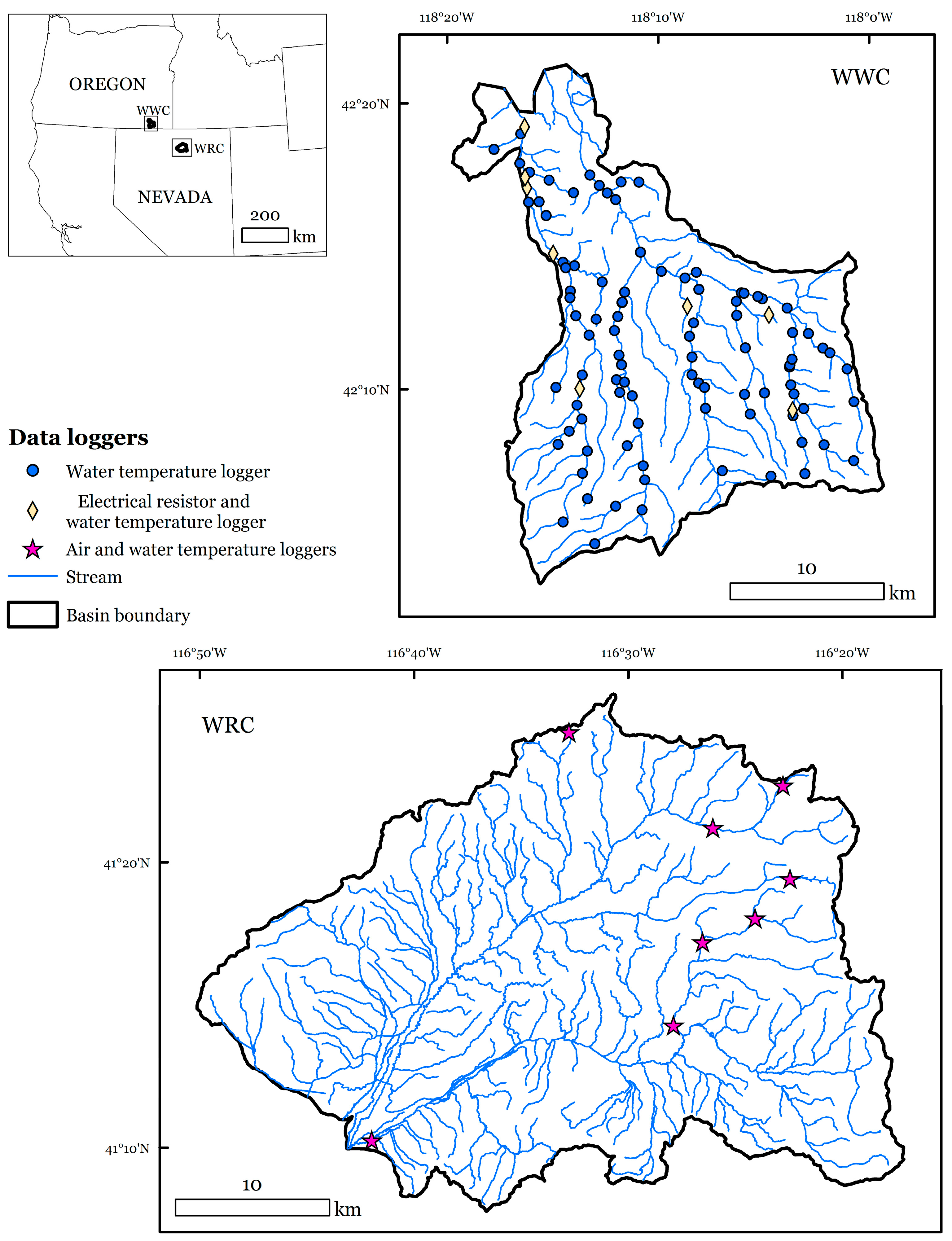
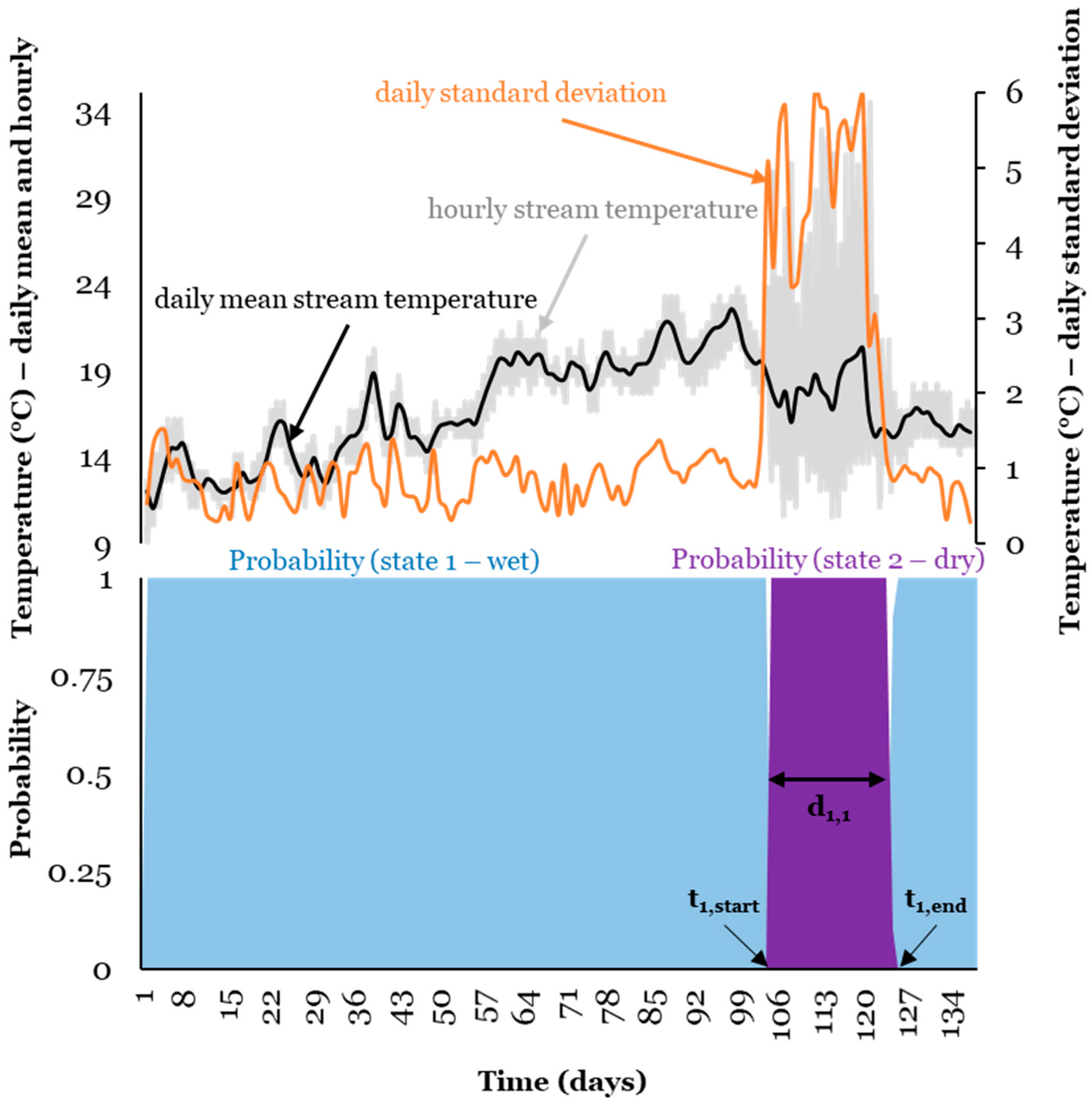
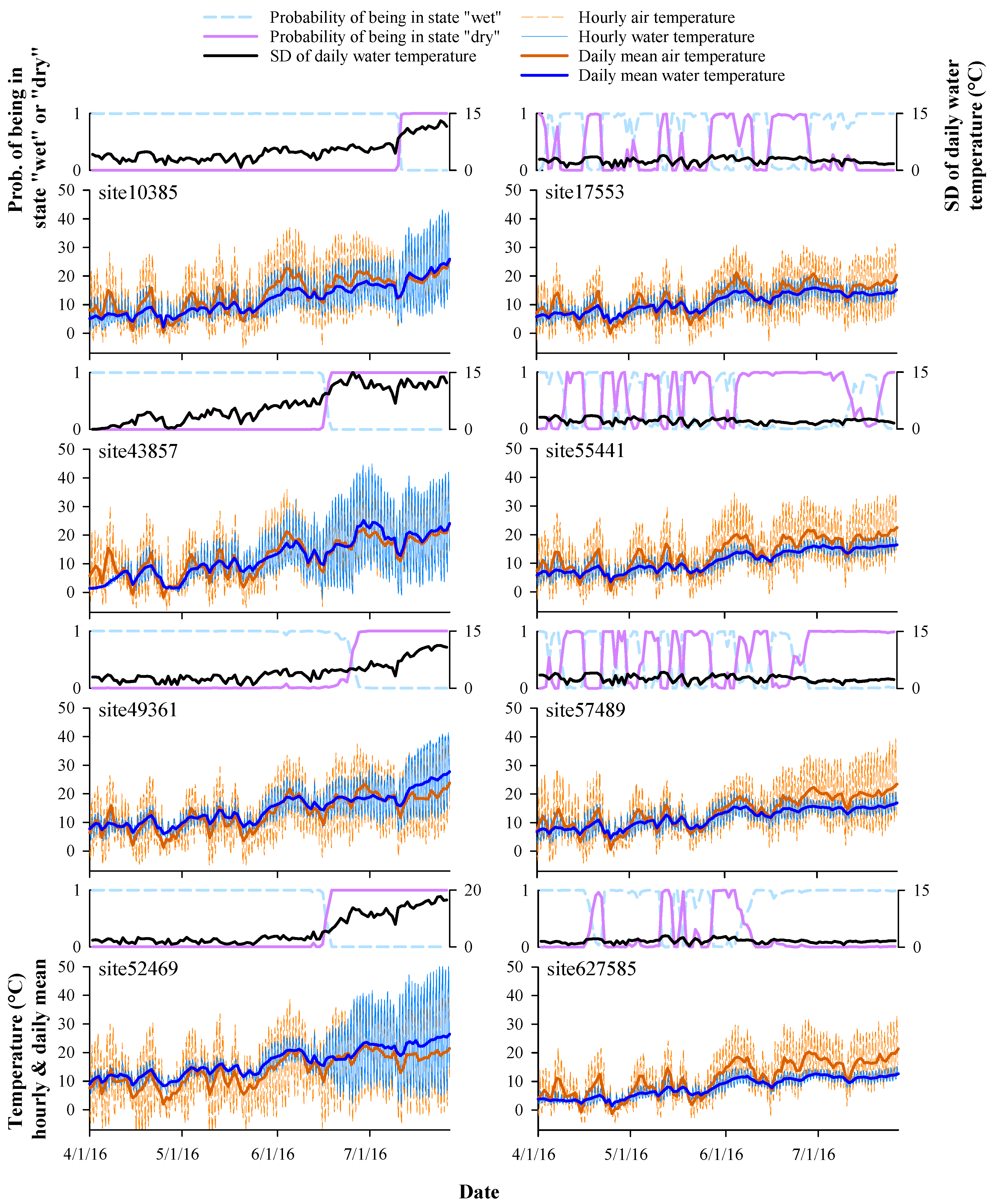
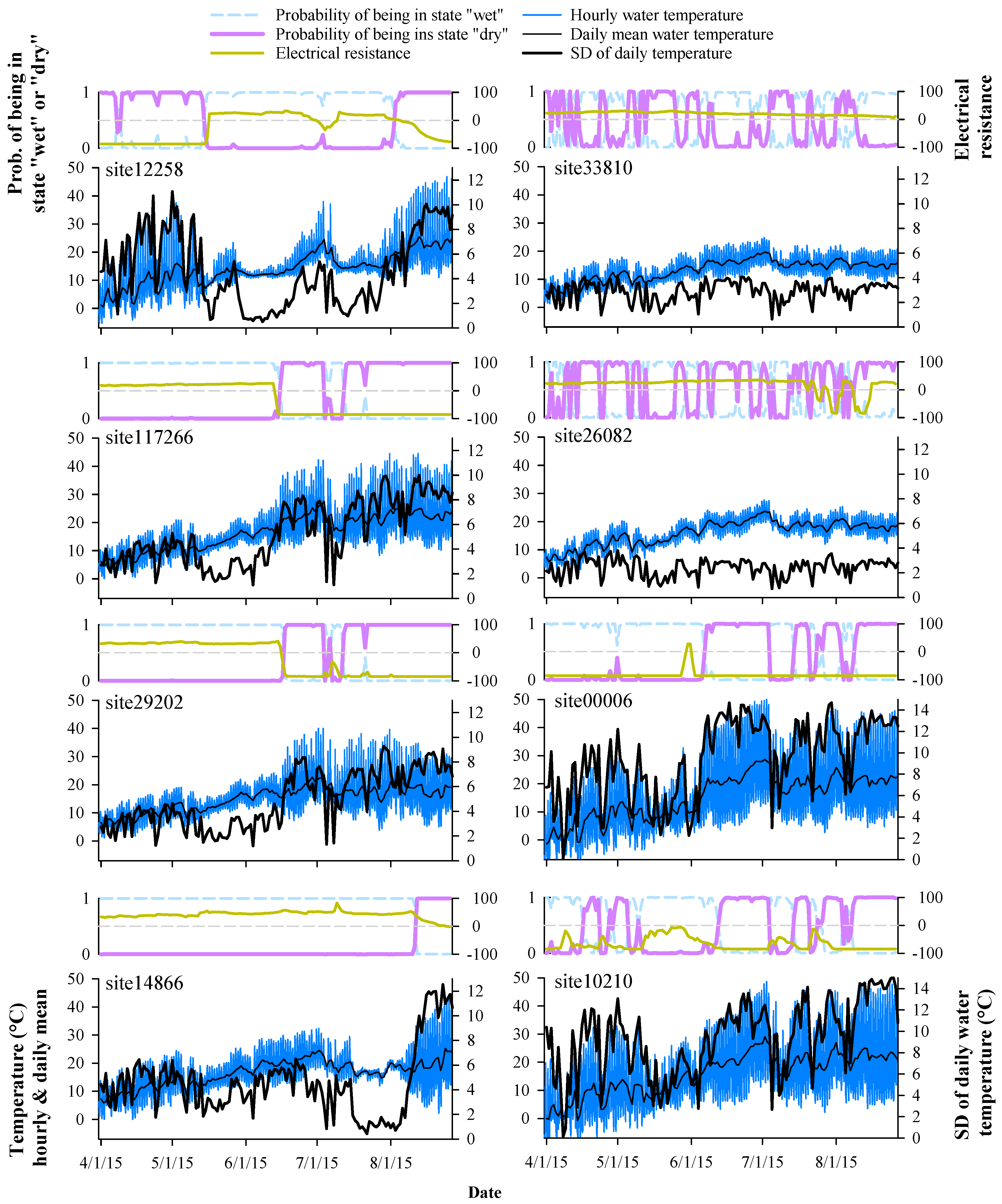
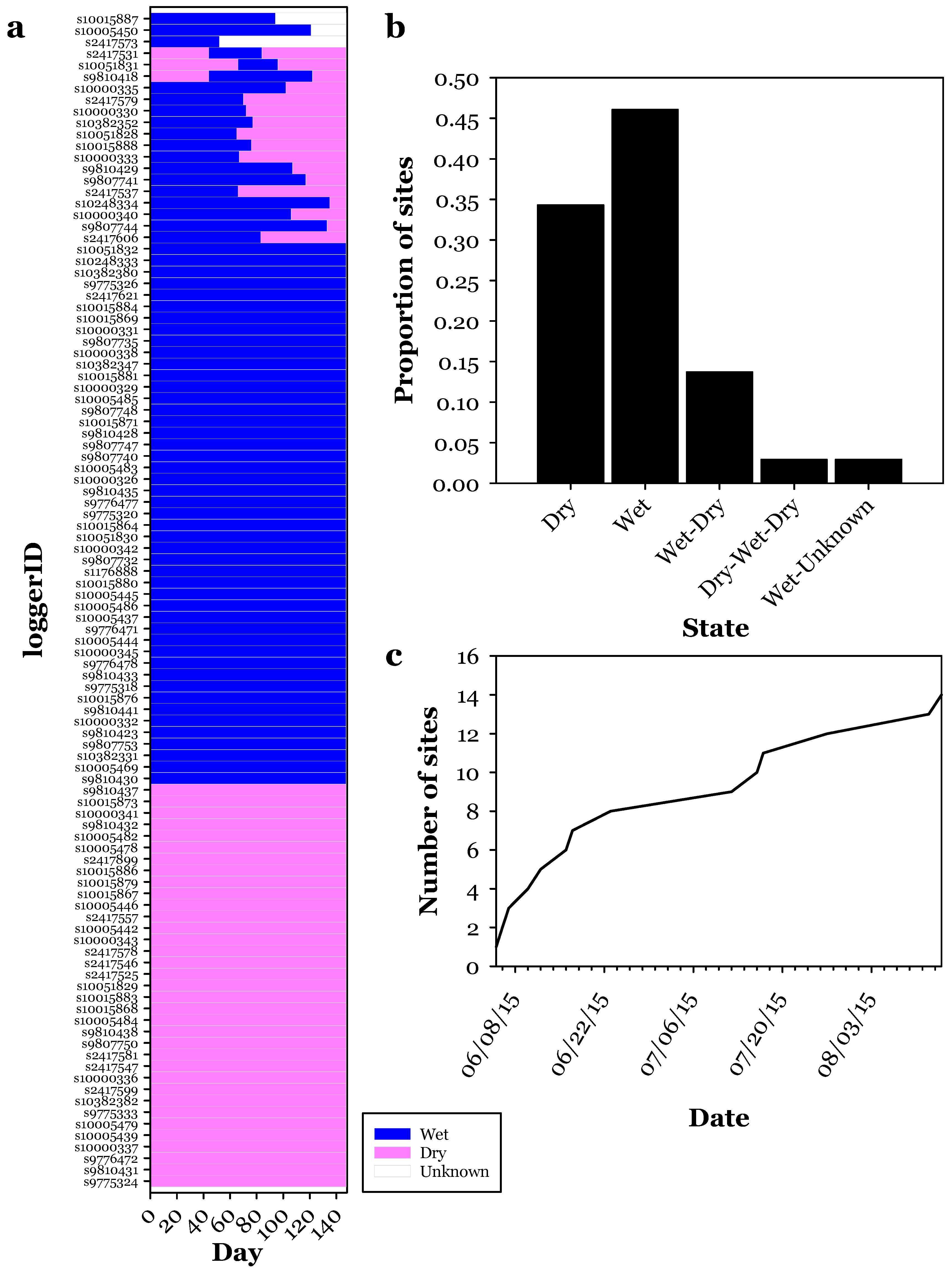
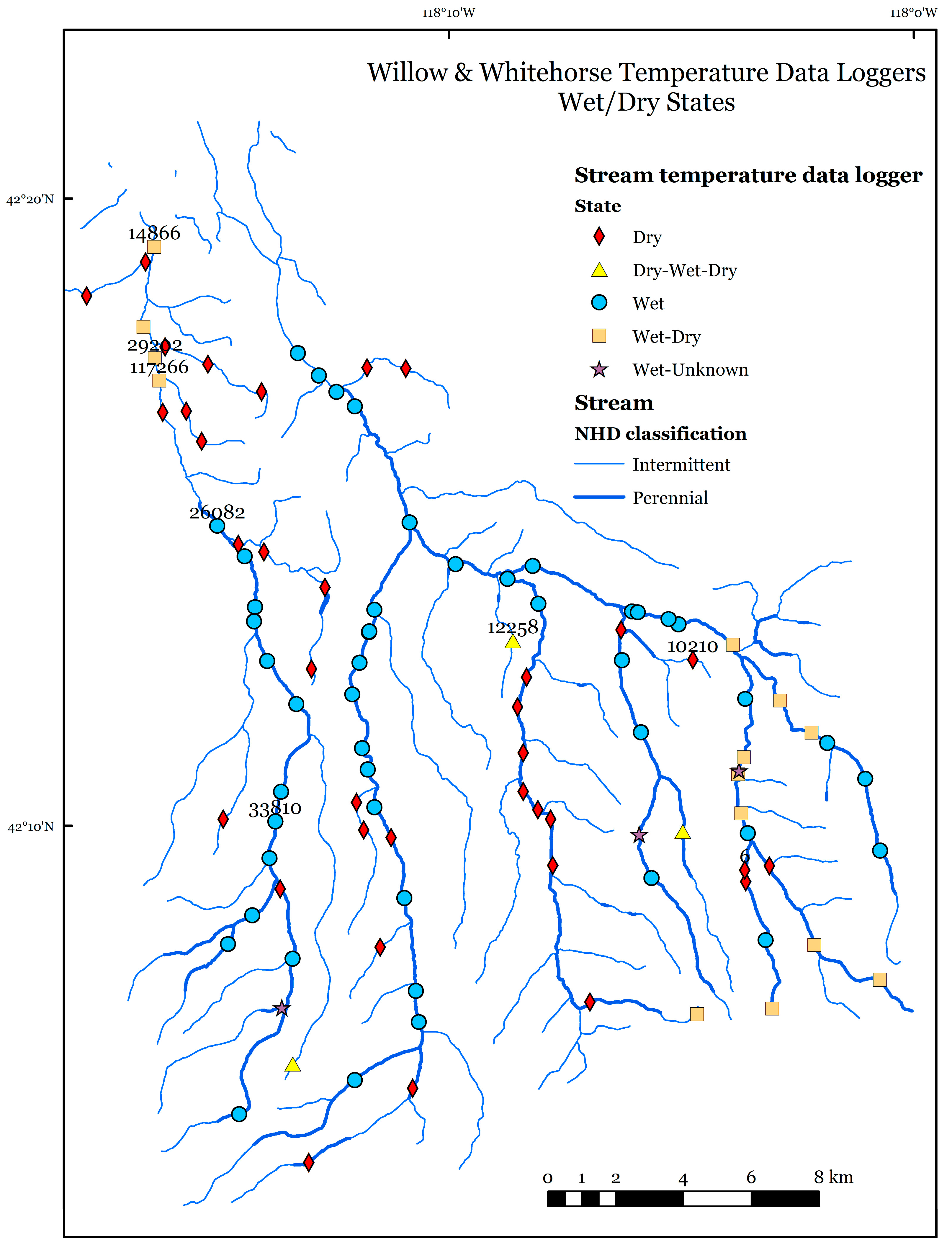
© 2017 by the authors. Licensee MDPI, Basel, Switzerland. This article is an open access article distributed under the terms and conditions of the Creative Commons Attribution (CC BY) license (http://creativecommons.org/licenses/by/4.0/).
Share and Cite
Arismendi, I.; Dunham, J.B.; Heck, M.P.; Schultz, L.D.; Hockman-Wert, D. A Statistical Method to Predict Flow Permanence in Dryland Streams from Time Series of Stream Temperature. Water 2017, 9, 946. https://doi.org/10.3390/w9120946
Arismendi I, Dunham JB, Heck MP, Schultz LD, Hockman-Wert D. A Statistical Method to Predict Flow Permanence in Dryland Streams from Time Series of Stream Temperature. Water. 2017; 9(12):946. https://doi.org/10.3390/w9120946
Chicago/Turabian StyleArismendi, Ivan, Jason B. Dunham, Michael P. Heck, Luke D. Schultz, and David Hockman-Wert. 2017. "A Statistical Method to Predict Flow Permanence in Dryland Streams from Time Series of Stream Temperature" Water 9, no. 12: 946. https://doi.org/10.3390/w9120946
APA StyleArismendi, I., Dunham, J. B., Heck, M. P., Schultz, L. D., & Hockman-Wert, D. (2017). A Statistical Method to Predict Flow Permanence in Dryland Streams from Time Series of Stream Temperature. Water, 9(12), 946. https://doi.org/10.3390/w9120946





